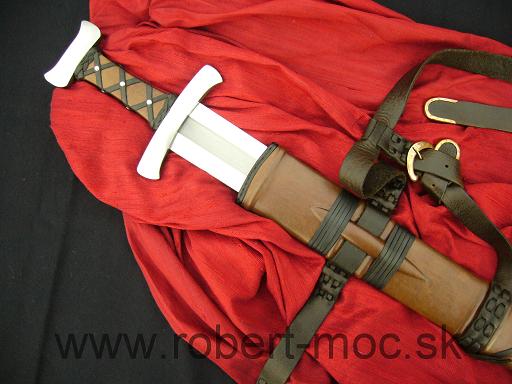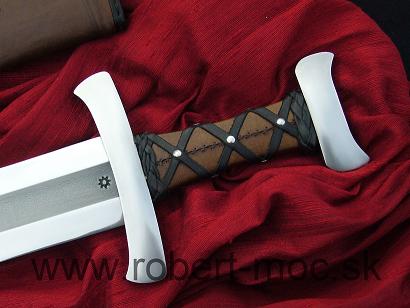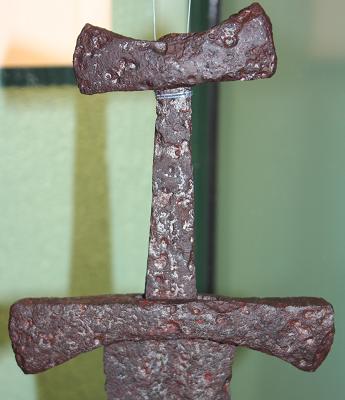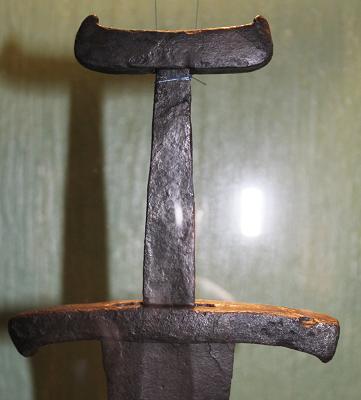Posts: 1,606 Location: Chicago, Illinois
Tue 13 Dec, 2011 3:58 pm
Custom Viking type Q from Robert Moc
Posts: 2,307 Location: Croatia
Tue 13 Dec, 2011 4:08 pm
it looks great and very interesting! I love the grip and the blade's
profile taper. Is the fuller just different finish or is it an iron core with welded steel edges maybe?
Posts: 1,606 Location: Chicago, Illinois
Tue 13 Dec, 2011 4:36 pm
| Luka Borscak wrote: |
| it looks great and very interesting! I love the grip and the blade's profile taper. Is the fuller just different finish or is it an iron core with welded steel edges maybe? |
No, just a different finish for the fuller. Does look nice though!
Posts: 1,903 Location: Toronto
Tue 13 Dec, 2011 6:40 pm
Wow Tim, that's really interesting and attractive. I also like the blade profile, and the scabbard / grip are also very nice. I don't remember seeing a double canoe design on the cross and pommel quite like that - do you have any photos of museum pieces that inspired this? -JD
Posts: 1,717 Location: Buffalo, NY.
Tue 13 Dec, 2011 10:12 pm
OK TIm- another outstanding and very interesting example!
I have never actually seen this pommel type before (I'm not as up on viking swords as I could be) but it is really facinating.
So I'm guessing a sword of this general type would have been around in the emergence of homogenous stell blades or at least iron core with steel edge blades?
Thanks for helping bring this beauty to life.
Posts: 1,606 Location: Chicago, Illinois
Wed 14 Dec, 2011 7:42 am
| Jeremy V. Krause wrote: |
OK TIm- another outstanding and very interesting example!
I have never actually seen this pommel type before (I'm not as up on viking swords as I could be) but it is really facinating.
So I'm guessing a sword of this general type would have been around in the emergence of homogenous stell blades or at least iron core with steel edge blades?
Thanks for helping bring this beauty to life. |
Yes, late 10th century would have been about right for this one. The type Q enjoyed a fairly long life compared to other viking hilt types. It seems a bit simple compared to some of the other viking styles but is still elegant.
Posts: 656
Wed 14 Dec, 2011 8:07 am
Tim,
I was going to send a joking response that I liked the old one better but I just didn't have the heart.
This is a striking ensemble, both overall and in the details. I like how the slight hourglass shape of the grip connects the cross guard and the pommel and the way the grip and the scabbard compliment each other, the blade is shaped beautifully and the contrasting finish on the fuller highlights the grace of the blade. The scabbard, the hilt, the blade are all beautiful in their own right but the way they've been brought together is the mark of true artistry.
Posts: 235 Location: Maryland USA
Wed 14 Dec, 2011 5:51 pm
I'm noticing that the museum examples all seem to be heavily corroded/aged, possibly with somthing missing. Is it possible these are upper guards with the lobed pommel missing? The pictures don't show enough to get a difinitive clue other than the shape that might lead to that possibility......
Posts: 669 Location: Dinuba, CA
Wed 14 Dec, 2011 6:25 pm
| Greg Ballantyne wrote: |
| I'm noticing that the museum examples all seem to be heavily corroded/aged, possibly with somthing missing. Is it possible these are upper guards with the lobed pommel missing? The pictures don't show enough to get a difinitive clue other than the shape that might lead to that possibility...... |
Then where would the lobes on every example have disappeared to? It seems pretty clear that this is a distinct style of hilt/pommel combination and that these nearly identical finds are valid displays of the type.
Lovely reconstruction, in any case. My only historical quip has to do with the wrap on the grip. I noticed that Robert does this on a lot of his swords, but in fact this style of wrapped thong doesn't really have any historical precedence before the 13th century or thereabouts, and then only with a very small amount of examples coming from art. He seems to do it to add character to his own work, which is cool... But it is rather distracting in its own right, considering the historicity.
-Gregory
Posts: 1,606 Location: Chicago, Illinois
Thu 15 Dec, 2011 4:45 am
| Greg Ballantyne wrote: |
| I'm noticing that the museum examples all seem to be heavily corroded/aged, possibly with somthing missing. Is it possible these are upper guards with the lobed pommel missing? The pictures don't show enough to get a difinitive clue other than the shape that might lead to that possibility...... |
There are hundreds of examples of this type of hilt. Petersen documented 122 in his work "De Norske Vikingesverd". It is clear that they had no upper pommel, because they have no holes to rivet an upper pommel to and because they are peened directly to the tang. Take a good look at the first museum example I posted. The peen is clearly visible dead center.
Posts: 1,606 Location: Chicago, Illinois
Thu 15 Dec, 2011 4:48 am
| Gregory J. Liebau wrote: |
My only historical quip has to do with the wrap on the grip.
|
Agreed. I'm not 100% on the grip either. I may redo it after I get it. Haven't decided yet...
Posts: 235 Location: Maryland USA
Thu 15 Dec, 2011 6:15 pm
I've also seen other opinions that some Viking swords had upper guards peened, with pommels then riveted to the upper guard.
http://www.hurstwic.org/history/articles/manu..._sword.htm
I'm not necessarily espousing that opinion, just mentioning it. There have been more than a few archeological finds misinterpreted in the course of time......... I certainly do like your sword in any case, its beautiful
Posts: 1,220 Location: Cork, Ireland
Thu 15 Dec, 2011 7:26 pm
Hey Tim, yet another beautiful addition to your already impressive collection. As for the grip, I'd leave it the way it is, as we really don't know how early this type was in use, and I definately think it adds some character to this piece. Also I like the way Robert used a sort of 'turks knot' to tie off the leather thong at either end of the grip.
Posts: 1,606 Location: Chicago, Illinois
Thu 15 Dec, 2011 7:30 pm
| Greg Ballantyne wrote: |
I've also seen other opinions that some Viking swords had upper guards peened, with pommels then riveted to the upper guard.
|
That's the standard for 2 part viking pommels. The pommel bar is peened and then the upper pommel is riveted to the pommel bar. The difference with a type Q (or type M, P, or AE) is that there are no rivet holes in the pommel bars of the examples; meaning no way to rivet the upper pommel into place. It's pretty reasonable to assume that, with several hundred examples between the types I mentioned, there were no upper pommels for these types.
Glad you like the sword! It arrived today but I wasn't home. I'll have to go to FedEx to get it. :\
Posts: 845 Location: The Netherlands
Fri 16 Dec, 2011 10:34 am
Beautiful sword Tim! Different, almost to the point of looking like fantasy, but still historical. I like that!
Posts: 1,903 Location: Toronto
Fri 16 Dec, 2011 3:23 pm
| Stephen Curtin wrote: |
| Hey Tim, yet another beautiful addition to your already impressive collection. As for the grip, I'd leave it the way it is, as we really don't know how early this type was in use, and I definately think it adds some character to this piece. Also I like the way Robert used a sort of 'turks knot' to tie off the leather thong at either end of the grip. |
I had similar thoughts. How can we know what was NOT used when we know next to nothing about what WAS used during this period? Absence of evidence etc. Its not a big stretch to imagine someone would have come up with this design in the Viking edge, when its known to have occurred later on single-hand medieval swords.
There's a drawing of a c1100 graveslab on p 77 of Oakeshott's 'Records' that depicts a cross-hatched grip design on a Viking-esque sword...not the same design as this one, but maybe in the same ball park. I suppose it could also represent carvings on a wood or bone handle - hard to tell from a drawing of a stone carving.
Anyhow, it looks good. :)
Posts: 669 Location: Dinuba, CA
Fri 16 Dec, 2011 5:10 pm
Gentlemen,
Certainly, we can never know the extent of what was used during any given historical period. All of the evidence is not available to us, so we must make due with what is discernible. If someone wants a historical sword, using "what if" sentiments is not a proper way to do things. Have you ever read a history book written by a professional that relies upon "what if" statements to make arguments? None that are worth their weight in paper do so.
This sword uses a style of grip wrap that is unknown from evidence until the 13th century. If Tim wants a historically accurate interpretation of a sword, then using this grip is just as farfetched as using an obscure, un-researched hilt and pommel combination, or blade style, or what have you... Having one aspect well researched without the other defeats the purpose of the entire project. If you want a fantasy sword grip, you may as well have the entire sword be fanciful.
That's my take. I think this sword deserves a more accurate grip.
-Gregory
Posts: 1,903 Location: Toronto
Fri 16 Dec, 2011 7:54 pm
| Gregory J. Liebau wrote: |
Gentlemen,
Certainly, we can never know the extent of what was used during any given historical period. All of the evidence is not available to us, so we must make due with what is discernible. If someone wants a historical sword, using "what if" sentiments is not a proper way to do things. Have you ever read a history book written by a professional that relies upon "what if" statements to make arguments? None that are worth their weight in paper do so.
This sword uses a style of grip wrap that is unknown from evidence until the 13th century. If Tim wants a historically accurate interpretation of a sword, then using this grip is just as farfetched as using an obscure, un-researched hilt and pommel combination, or blade style, or what have you... Having one aspect well researched without the other defeats the purpose of the entire project. If you want a fantasy sword grip, you may as well have the entire sword be fanciful.
That's my take. I think this sword deserves a more accurate grip.
-Gregory |
I'm confused by your position. If we do not know what grip coverings these swords had, then what do you mean by a more accurate grip?
The point made above by a couple of people was that the tiny amount of data on grips from this early era available today (the sample) do no allow one to make statistical inferences about the population (perhaps thousands of swords made during that era), let alone specific variants based on region, culture, personal taste, style, and sword types within this population. Thus not only do we not know if this particular grip covering was accurate - we cannot know if any alternative perishable grip style is historically accurate for this sword type.
Unless there happens to be rare archeological evidence or a period illustration that clearly shows the grip covering and its materials for one of these swords (Q with AE characteristics)...? That would be a stroke of luck.
Otherwise one has no choice but to speculate. I do not regard this to detract from the sword if its based on sound reasoning.
Posts: 669 Location: Dinuba, CA
Fri 16 Dec, 2011 8:15 pm
| J.D. Crawford wrote: |
| I'm confused by your position. If we do not know what grip coverings these swords had, then what do you mean by a more accurate grip? |
My position is simple. One must use the most historical grip styles known to us in order to create accurate reconstructions. A reproduction that utilizes styles that are not aligned with the historical data, however limited it may be, immediately become hypothetical in nature. For any reproduction to remain accurate in its overall construction, it necessarily has to be made with existing evidence in mind, in every feature. If there is no information available for a certain aspect, such as a style of grip wrap, then logical reconstructions can become acceptable. But, to extrapolate and include details that no evidence exists for until hundreds of years after the sword in question was used is above and beyond the flavor of "faithful reproduction."
If Tim doesn't wish to have an accurate reproduction of this sword type, then that's fine... But he already seems to have agreed with me that the grip wrap is questionable, which I strongly think it is. Just because something may have happened in history, does not mean that it did, or that it is reasonable to assume it did based on a lack of overall evidence. If such conclusions were acceptable, then historians would have no jobs, archaeologists no need to dig and us no need to search for any truth in history.
And I want to be very clear: this is my opinion of the considerations Tim should have if, and only if, he wishes such a reproduction as this to remain faithful to the credible body of evidence. If he wants to extrapolate... So be it. No harm done. I'm coming at this from a purely, well, purist perspective, and am playing devil's advocate. I think this is a lovely sword and the grip looks great. It's a style I love! I just think that historically for a sword as early as this, it throws things off a bit.
-Gregory
You
cannot post new topics in this forum
You
cannot reply to topics in this forum
You
cannot edit your posts in this forum
You
cannot delete your posts in this forum
You
cannot vote in polls in this forum
You
cannot attach files in this forum
You
can download files in this forum








